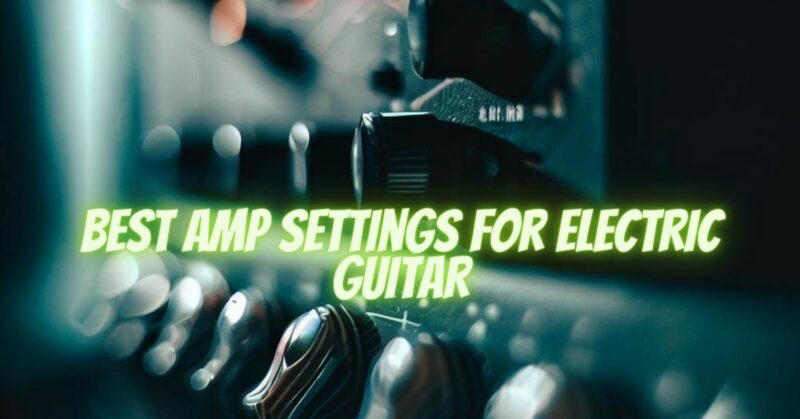The electric guitar is a versatile instrument that can produce a wide range of tones and styles. To fully harness the sonic potential of your electric guitar, dialing in the right amp settings is crucial. In this article, we’ll delve into the realm of electric guitar and explore the best amp settings to help you unlock a world of captivating sounds and express your musical vision.
- Start with a Clean Slate:
Begin by setting all the controls on your amp to a neutral or flat position. This ensures a clean starting point, allowing you to sculpt your tone from a blank canvas. Set the EQ controls (bass, midrange, and treble) to the midpoint or 12 o’clock position.
- Experiment with Gain:
The gain control on your amp determines the level of overdrive or distortion in your sound. For clean tones, keep the gain low or off. Increase the gain gradually to add crunch, grit, and sustain to your sound. Finding the sweet spot that suits your playing style and musical genre is key. Higher gain settings are ideal for rock, metal, and heavier genres, while lower gain settings work well for blues, jazz, and cleaner styles.
- Balance the EQ:
Fine-tuning the EQ controls is essential to shape your electric guitar’s tone. Here’s a general guideline to get you started:
- Bass: Adjust the bass control to control the low-end frequencies. Increase the bass for a fuller and heavier sound, ideal for genres like rock or metal. Decrease the bass for a tighter and more focused sound, suitable for genres like funk or fusion.
- Midrange: The midrange control has a significant impact on the guitar’s presence and cutting ability. Boost the midrange for a more aggressive and prominent sound, perfect for solos or when you want your guitar to stand out. Cut the midrange for a smoother and rounded tone, suitable for rhythm playing or vintage-inspired sounds.
- Treble: The treble control shapes the high frequencies of your guitar’s tone. Increasing the treble adds brightness and clarity, allowing your guitar to cut through the mix and emphasize harmonics. Lowering the treble can result in a warmer and smoother sound, ideal for jazz or blues playing.
- Experiment with Effects:
Electric guitarists often embrace effects pedals to enhance their sound. Experiment with effects like reverb, delay, modulation (chorus, flanger, phaser), and distortion/overdrive pedals to add texture, depth, and personality to your tone. Each effect can shape your sound in unique ways, so use them tastefully to enhance your playing without overwhelming the overall mix.
- Consider Speaker Cabinet and Mic Placement:
If you have the option to adjust speaker cabinet settings or mic placement, take advantage of it. Different speaker cabinets and mic positions can alter the tonal characteristics of your electric guitar sound. Moving the mic closer to the speaker cone produces a brighter and more focused sound, while moving it farther yields a softer and more ambient sound. Experimentation is key to finding your preferred cabinet and mic setup.
- Volume and Presence:
The volume control on your amp not only affects the overall loudness but also influences the dynamic response and tone. Higher volumes often result in more natural tube saturation and a livelier feel. The presence control, if available, adjusts the high-frequency response, allowing you to add shimmer and brilliance or tame any harshness.
- Trust Your Ears and Personalize:
Ultimately, your ears are the best judge of your electric guitar’s tone. Use the suggested settings as a starting point, but don’t be afraid to trust your instincts and make adjustments based on your personal preferences and musical context. Spend time experimenting, listening attentively, and fine-tuning until you discover the perfect amp settings that bring your electric guitar to life.
Conclusion:
The electric guitar offers a vast sonic playground, and with the right amp settings, you can unlock a world of possibilities. By experimenting with gain, balancing the EQ, exploring effects, considering speaker cabinet and mic placement, and trusting your ears, you’ll be well on your way to crafting a personalized and captivating electric guitar sound. Embrace the power of experimentation, and let your electric guitar journey take flight!


